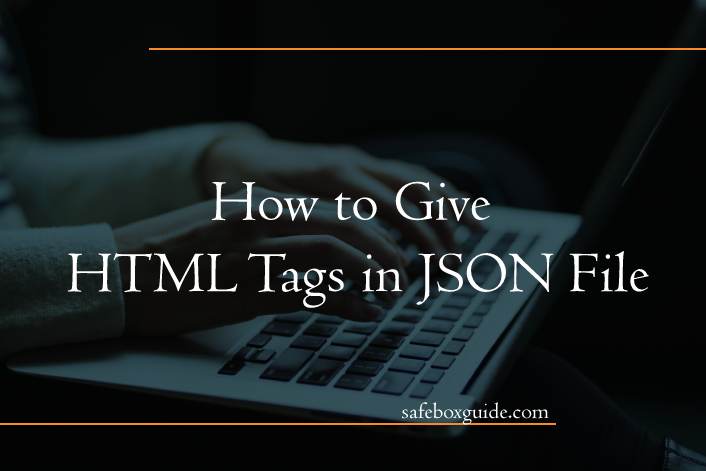HTML is a markup language that allows developers to create web pages with various types of content such as text, images, videos, forms, and many more. JSON, on the other hand, is a lightweight data-interchange format used to transmit and store data. In some cases, developers may need to use HTML tags in JSON files to display rich content on web pages or mobile applications. In this article, we will explore how to give HTML tags in JSON files and some best practices to follow.

Contents
Understanding JSON
Before we dive into the specifics of giving HTML tags in JSON files, it is essential to understand the basics of JSON. JSON stands for JavaScript Object Notation and is a lightweight format for transmitting data. It uses a simple syntax to represent data as key-value pairs or arrays.
JSON data is often used to exchange data between a server and a web application. The data is sent as a string and can be easily parsed by most programming languages. Here’s an example of a JSON object:
jsonCopy code
{
“name”: “John Doe”,
“age”: 30,
“address”: {
“street”: “123 Main St”,
“city”: “Anytown”,
“state”: “CA”
},
“phone numbers”: [
{
“type”: “home”,
“number”: “555-555-1234”
},
{
“type”: “work”,
“number”: “555-555-5678”
}
]
}
As you can see, JSON data is represented using curly braces for objects, square brackets for arrays, and key-value pairs separated by colons. Now, let’s explore how to give HTML tags in JSON files.
Giving HTML Tags in JSON Files
To give HTML tags in JSON files, you need to use special characters to represent the HTML tags. Here are some of the most common characters used to represent HTML tags in JSON:
- < as <
- > as >
- & as &
For example, let’s say you want to include a paragraph tag in a JSON object:
jsonCopy code
{
“name”: “John Doe”,
“bio”: “Lorem ipsum dolor sit amet, consectetur adipiscing elit. Ut gravida, lorem ut tempor ullamcorper, tellus magna tincidunt nisi, non vulputate magna turpis non enim. Duis vehicula faucibus mauris, nec convallis ipsum. Mauris consequat enim eu urna venenatis imperdiet. <p>Mauris efficitur nunc id risus congue convallis.</p> Sed vel malesuada sapien.”
}
As you can see, we used the special character < to represent the < symbol and > to represent the > symbol. We also included the paragraph tag inside the string value of the bio key.
Here’s how the JSON data would look when rendered as HTML:
htmlCopy code
<div>
<h1>John Doe</h1>
<p>Lorem ipsum dolor sit amet, consectetur adipiscing elit. Ut gravida, lorem ut tempor ullamcorper, tellus magna tincidunt nisi, non vulputate magna turpis non enim. Duis vehicula faucibus mauris, nec convallis ipsum. Mauris consequat enim eu urna venenatis imperdiet. </p>
<p>Mauris efficitur nunc id risus congue convallis.</p>
<p>Sed vel malesuada sapien.</p>
</div>
As you can see, the paragraph tag was properly rendered in the HTML output.

Best Practices
When giving HTML tags in JSON files, it is important to follow some best practices to ensure that your JSON data is properly formatted and can be easily parsed by web browsers or mobile applications.
1. Use Valid JSON
First and foremost, make sure that your JSON data is valid. This means that it should follow the syntax rules of JSON and that all key-value pairs are separated by colons and enclosed in curly braces. Invalid JSON data can cause parsing errors and prevent the HTML tags from being properly rendered.
2. Escape Special Characters
As mentioned earlier, special characters such as <, >, and & should be properly escaped to prevent parsing errors. Always use the correct escape sequences to represent these characters.
3. Use Simple HTML Tags
When using HTML tags in JSON data, it is best to stick to simple tags such as paragraphs, headings, and lists. Avoid using complex tags such as tables, forms, and iframes, as they can cause rendering issues or may not be supported by all browsers or mobile devices.
4. Keep the HTML Separate
In some cases, it may be better to keep the HTML separate from the JSON data. Instead of including HTML tags in the JSON data, you can include a reference to the HTML content, which can be stored in a separate file or database.
For example, you can include a key called content in your JSON data, which contains a URL to the HTML file:
jsonCopy code
{
“name”: “John Doe”,
“content”: “https://www.example.com/content.html”
}
This approach allows you to keep your JSON data clean and simple, while also providing the flexibility to update the HTML content separately.
Giving HTML tags in JSON files can be a useful technique for displaying rich content on web pages or mobile applications. By properly escaping special characters and following best practices, you can ensure that your JSON data is properly formatted and can be easily parsed by web browsers or mobile devices.
Remember to keep your HTML tags simple and consider keeping the HTML content separate from the JSON data. With these tips in mind, you can create dynamic and engaging web pages and mobile applications using JSON and HTML.

